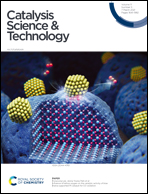Mechanism of the hydrocarbon resistance of selective catalytic reduction catalysts supported on different zeolites†
Abstract
The variations in the hydrocarbon resistances of catalysts were usually attributed to the pore structure. In this study, the deactivation of C3H6 on Cu–Mn/ZSM-5 and Cu–Mn/SAPO-34 was investigated in the context of the reaction process. Results revealed that when C3H6 was adsorbed on the catalysts, it could be oxidized to acrolein and eventually to acrylate, which could occupy the hydroxyl groups on the catalysts and inhibit the formation of the intermediates of the selective catalytic reduction (SCR) reaction of NOx complexes and NH3 species. The C3H6 on Cu–Mn/SAPO-34 had a lower adsorption amount than that on Cu–Mn/ZSM-5. In addition, the former could maintain two of the three hydroxyl groups linked on the metal sites to form the intermediates in the SCR reaction. This reaction, which could occur through the Langmuir–Hinshelwood model, led to the higher resistance of Cu–Mn/SAPO-34 than Cu–Mn/ZSM-5.



 Please wait while we load your content...
Please wait while we load your content...